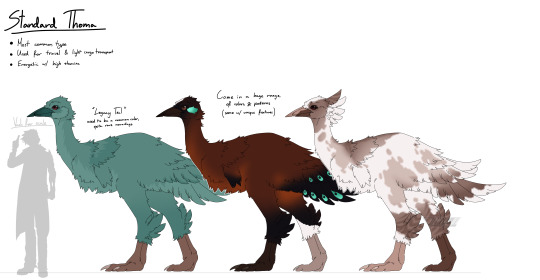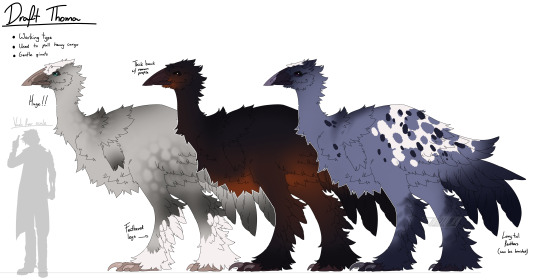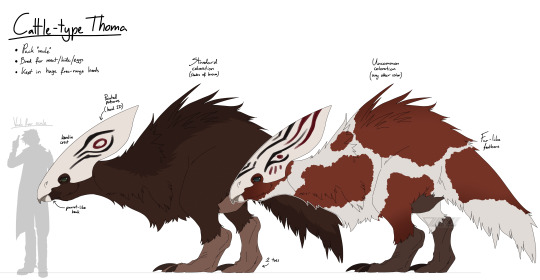#but lets say they adapt fast due to genetic modification
Text




cowboy au worldbuilding with the thoma
as you can see im taking some creative liberties with the giant emu by making them more diverse bc canon isnt enough for me and i have the brainworms
extra notes below the cut
standard thoma:
the original thoma and most common type available
perfect for travel, can pull wagons or carry light cargo
fast with good stamina, fastest over short distances
friendly, intelligent, energetic and quick to learn
the most diverse in terms of colors, patterns and extra traits
well rounded in all departments (theyre like the AQ horses of trigun)
draft thoma:
uncommon outside of major cities (kept by specialized breeders)
used for construction work and long haul heavy cargo transport
gentle, patient and eager to work
not built for speed but can walk for days at a steady pace without rest
dense feather coat protects them from the heat and sand
expensive to maintain and keep due to their size
theyre a relatively new type that came from selective breeding
"wild" thoma:
actually feral (aka. previously domesticated), not wild
originating from lost/runaways that have not been in contact with humans for generations
rare and elusive with a small population, sometimes spotted living near shipwrecks
people will pay top $$ for their capture
begin to exhibit adaptive mutations that help them survive the wastelands
smaller and less fluffy than their standard counterparts
dont come in many colors, mostly bays, chestnuts and blacks
hardy with incredible endurance
very stubborn, temperamental and intelligent, cant be forced to do something they dont want (like donkeys)
rarely ridden, mostly kept for crossbreeding
cattle-type thoma:
related to the standard thoma but NOT the same species
common pack animal in caravans, sometimes ridden as a cheaper alternative to the standard thoma
mainly bred for meat, hide and eggs
kept in huge open range herds that travel along worm swarms for feeding
sometimes kept as a form for anti-worm pest control
keratin crests are lightweight and used for protection and display
ranchers will paint patterns on their crests as a form of identification
not the sharpest tools in the shed, tend to bite and trample people
#trigun#trigun stampede#cowboy au#worldbuilding#andr0art#i like speculative biology idk what to tell you#its the brainworms#sorry for the horrible handwriting btw#also ik that significant adaptive mutations take longer to appear than a 100 years#but lets say they adapt fast due to genetic modification#the implications of what seeds did after the fall to adapt to the wastelands fascinates me#since thoma arent native to no mans land iirc#did they just have them on board?#what ab other animals?#what kind of non-native wildlife is there#i know there are birds and like... a cat#<- still hasnt read trimax#everything i know has been obtained via tristamp and osmosis#also yes im bringing in the og thoma#diversity win!#i needed a substitute for cows so vash and wolfwood have something to herd for cash#living the cowboy dream baby!
504 notes
·
View notes
Text
NZ genetic engineering laws 'old and tired', top scientist says
New Post has been published on https://diary.nz/nz-genetic-engineering-laws-old-and-tired-top-scientist-says/
NZ genetic engineering laws 'old and tired', top scientist says
New Zealand’s top scientist has acknowledged our laws around genetic engineering are “old and tired”, amid renewed calls for a fresh look at the contentious topic.
Prime Minister’s chief science advisor Professor Juliet Gerrard said the country’s working legal and regulatory frameworks were struggling to cope with technologies that hadn’t been invented when the laws were written two decades ago.
“We need a framework that is future proof and enables us to focus on the issues, not the loopholes,” she told the Herald.
“Such a framework needs to facilitate a broad public conversation.”
Strict regulations under the HSNO Act have tightly controlled the use of genetic engineering (GE) and genetically modified organisms (GMOs) in New Zealand since 2003.
Over that time, calls for a review – or at least a national discussion – have been mounting.
Today, Gerrard’s predecessor in the top role, Professor Sir Peter Gluckman, also weighed in on the issue.
In a keynote speech to Horticulture NZ’s conference at Hamilton’s Mystery Creek, he said the new technologies could offer “enormous potential” for a country that was, and likely always would be, a biological-based economy.
“If our country does not periodically consider how to use or not use evolving technologies, we run the risk of becoming a backwater with a declining competitive position,” he said.
“However, it is not for science to decide on technologies, but at the same time it is doubtful that the traditional political processes are the appropriate way to deal with the complexities of the interplay between science, values and world views.”
Gluckman said New Zealand needed a way to consider all fast-changing technologies – whether digital or life science or any other – on an adaptive basis, but still maintaining “rational precaution and pragmatic realism”.
“New models of adaptive regulatory oversight are needed globally. Similarly, new models of bringing science and citizens together to discuss these issues of post-normal science are needed.
“We must to find a way to have ongoing conversations about such fast moving and evolving technologies; burying our heads in the sands of short-termism can have serious long-term costs.”
BiotechNZ chief executive Dr Zahra Champion echoed those comments, pointing out that New Zealand was “built on innovation” and needed to be part of cutting-edge science.
Tools like gene editing could complement other technologies to tackle global issues, she said.
One such issue was climate change. This month, the Government’s Interim Climate Change Committee raised concerns that GM laws could be a barrier to lowering farming emissions.
It gave the example of a genetically modified ryegrass developed by AgResearch that may potentially reduce both methane and nitrous oxide emissions from grazing animals, but that was having to be tested in the United States and would not be able to be used in New Zealand under current laws.
Professor Juliet Gerrard says the country’s regulatory frameworks were struggling to cope with technologies that hadn’t been invented two decades ago when the laws were written. Photo / NZ Herald
Another area was conservation.
On the back of one recent scientific review that found current approaches wouldn’t be enough to reach the country’s goal of clearing all rats, stoats and possums from the mainland by 2050, conservation heavyweight Sir Rob Fenwick said it was time Kiwis talked about what new technology might be needed.
Gerrard said the debate around GE was taking place around the world, and the questions that needed addressing were broad.
The Royal Society Te Apārangi was soon due to release a comprehensive report – much of which was already available on its website – and Gerrard would be writing an accompanying commentary for Prime Minister Jacinda Ardern.
However, the Government has so far signalled little movement on GE.
Although Cabinet had agreed to look at broader legislative framework – including genetic engineering – the minister in charge of the HSNO Act, Environment Minister David Parker, said there was no current work going on to review it.
“There is an issue that’s coming at New Zealand, which is whether some of the new GMO techniques are not properly catered for in the HSNO legislation, which was drafted before new techniques were developed,” Parker told Parliament’s latest environment select committee meeting.
“There are mixed views in society as to whether those new techniques do have an effect to modify the genome of an existing organism, and we are seeking advice on those issues before we move forward.”
“If our country does not periodically consider how to use or not use evolving technologies, we run the risk of becoming a backwater,” Professor Sir Peter Gluckman says. Photo / NZ Herald
Two of his Cabinet colleagues, Forestry Minister Shane Jones and Agriculture Minister Damien O’Connor, have both suggested that it was time to talk about GE.
“Let’s push the waka out and find out whether or not what we are taking as gospel is indeed still, in this new climate change environment, the gospel we want to believe in,” Jones told the Herald this month.
Yesterday, O’Connor said a “sensible, mature conversation” was needed.
He added that GE was not going to be a silver bullet for any of the country’s challenges, but “one of the tools in our toolbox over time and we have to look at that very carefully”.
O’Connor highlighted worries around the potential risks that opening New Zealand to genetic modification could have for access to overseas markets increasingly concerned with organic products.
“New Zealand does have an advantage in the marketplace being GMO free, so those who are selling our products have to weigh up what the introduction of genetic engineering in whatever form may mean to their marketing opportunities.
“But genetic engineering around the world is opening up some opportunities and we have to be mindful of those and be prepared to open the door where we see net advantage over time.”
The National Party has taken a similar stance, arguing that, although environmental credentials were an increasing part of what consumers worried about, the conversation was worth having.
The worry about the brand has also been raised by Climate Change Minister James Shaw, whose Green Party remained opposed to genetic engineering, and lobby group GE Free New Zealand.
“If New Zealand had the strongest GMO regulations in the world, that would be appealing to a large section of the premium market globally,” GE Free spokesman Jon Carapiet said.
– Additional reporting: Boris Jancic
Source link
0 notes